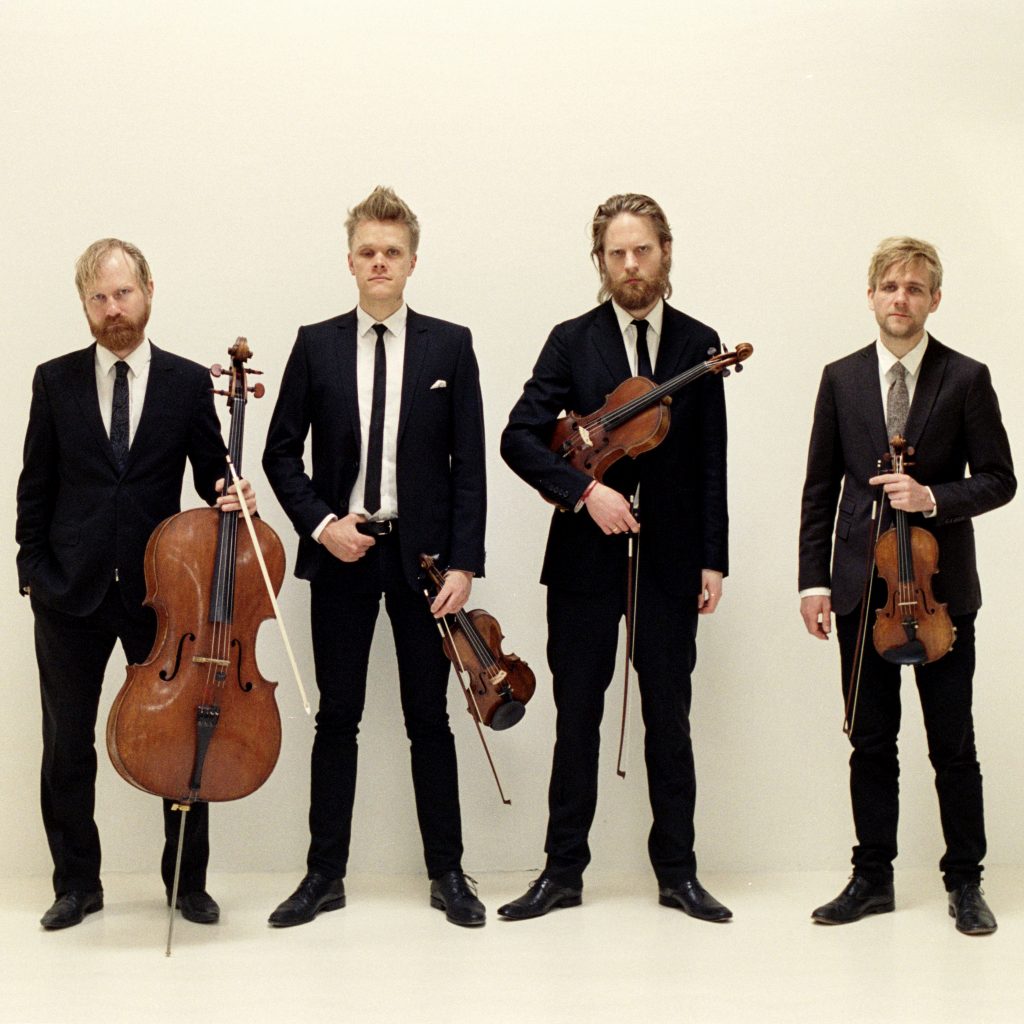The Danish String Quartet Combines Exciting Repertory and Sublime Playing
Following their established pattern of visiting San Diego, the Danish String Quartet was overdue. But the sizzling concert by this accomplished young ensemble on Friday, February 8, in the Auditorium at TSRI, certainly made up for lost time.

The Danish String Quartet [photo (c.) Caroline Bittencourt]
I missed their informal performance Thursday at a gallery in Barrio Logan, but Friday’s program delivered an embarrassment of riches: after their electric accounts of two familiar “hunt” quartets—Haydn’s Op. 1, No. 1, “La Chasse,” and Mozart’s B-flat major. K. 458 “The Hunt”—they launched into Jörg Widmann’s audacious 2005 “Hunting Quartet” followed by Carl Nielsen’s rarely heard First String Quartet in G Minor from 1888. And they returned Saturday, Feb. 9, at the Auditorium at TSRI for a program of folk music from Nordic sources.
What sets the Danish String Quartet apart from other esteemed touring quartets is its vigorous physical engagement with the music, an irresistible zeal that overrides the sedate traditions of the genre without sacrificing for a nanosecond the precision of their pristine ensemble.
Widmann’s “Hunting Quartet,” a twelve-minute hurricane of tightly coiled, rapid themes laced with extended instrumental techniques, shouts, and growls, proved a perfect fit for this athletic quartet. First violinist Rune Tonsgaard Sørensen and cellist Fredrik Schøyen Sjölin outdid one another executing extravagant glissandos, and violinist Frederik Øland and violist Asbjørn Nørgaard joined their colleagues in myriad sonic feats, such as plucking violent pizzicatos and coaxing grating string sounds from both sides of the bridge.
Widmann’s “hunting” conceit, however could not be further from the 18th-century composers’ playful thematic use of cheerful hunting horn calls—a kind of second cousin to the bugle calls you hear at a contemporary racetrack—in rollicking 6/8 meters. No, Widmann engages his musicians in a virtual hunt, slinging musical arrows at the poor cellist, who does not survive (musically, that is) the piece.
With the Danish String Quartet, this scenario takes on political overtones, inasmuch as the only non-Dane is the cellist, who is Norwegian. Perhaps I am reading too much into the program. In any case, the typically proper La Jolla Music Society audience cheered this new piece with raucous gusto. For the record, that is not their typical response to an avant-garde work such as Widmann’s.
I was also quite excited to hear Nielsen’s rarely played First String Quartet, an exuberant piece plotted in the expected four-movement structure of most string quartets, but evidencing clear symphonic aspirations in its broadly scaled themes. For this quartet, violinists Sørensen and Øland traded places, which certainly evened out the concert’s workload between those two musicians. However, because their timbres and approach to phrasing are so beautifully matched, I did not notice a difference with the position switch.
Øland’s winning cantabile main theme of Nielsen’s first movement, Allegro energico, was complemented by cellist Sjölin’s lustrous reverie in the slow second movement. All four players evoked rambunctious traditional musicians in the Scherzo, which sounded like a slightly bumptious village dance. While it is understandable that the Danish String Quartet would program Denmark’s most noted composer, there is no reason why other string quartets should not include this fine, inventive work in their repertory.
Mozart’s B-flat Major Quartet, K. 458, showcased the Danish String Quartet’s supple, pellucid ensemble work, shedding keen interpretive light on the composer’s sophisticated textures. First violinist Sørensen turned the Adagio into an ardent operatic aria, deftly accompanied by willing colleagues.
Could these players have communicated a more playful, carefree account of Haydn’s Op. 1, No. 1, “La Chasse”? They matched their delectable exuberance of the outer Presto movements with an array of well-tuned, contrasting emotions in the inner movements of this early string quartet that is really a divertimento. “La Chasse” proved a gentle welcome to a bracing, rewarding musical journey with the Danish String Quartet. For their sole encore, the quartet offered Carl Nielsen’s “Mit hjerte altid vanker,” a Danish Lutheran hymn usually translated “My Heart Remains in Wonder.”
The Danes have promised to return to San Diego after the La Jolla Music Society opens its new concert hall, The Conrad, in downtown La Jolla. For that event, I intend to be first in line!
This concert was presented by the La Jolla Music Society on Friday, February 8, 2019, in The Auditorium at TSRI.

Ken Herman, a classically trained pianist and organist, has covered music for the San Diego Union, the Los Angeles Times’ San Diego Edition, and for sandiego.com. He has won numerous awards, including first place for Live Performance and Opera Reviews in the 2017, the 2018, and the 2019 Excellence in Journalism Awards competition held by the San Diego Press Club. A Chicago native, he came to San Diego to pursue a graduate degree and stayed.Read more…


